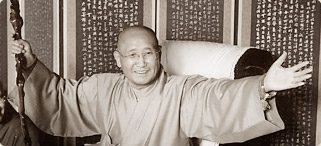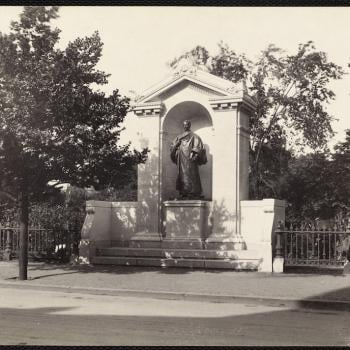Regular readers of my Monkey Mind blog probably know the streams of Zen within which I practice derive through Japan. What people who do not practice Zen may not understand is how different the styles of Zen can be based a great deal upon what nations within which they took their shape. Nonetheless Japanese Zen is Zen, Korean Seon is Zen, Chinese Chan is Zen. Actually we’re all Chan, as that’s the ultimate source for our school.
This is one reason, among many, why I am so fascinated with the first tentative steps in forming of a Western Zen, or probably more correctly a North American Zen. (There will almost certainly also be a European Zen, maybe a South American Zen and possibly an African Zen. But I have not followed these tentative shoots as closely as what’s going on here in North America…) The point is wherever it takes root, Zen is going to have a new and unique shape. No doubt.
But for it to be real Zen it must share some common characteristics. What these charateristics are is hard to name with much specificity. I suspect a devotion to just sitting practice and koan introspection to one degree or another will be essential. I also believe some understanding of lineage will be a fundamental mark of Zen in the west, although how that will come to be understood is pretty dynamic. Much of the rest is probably up for grabs, even possibly whether it need be Buddhist. There are a lot of tentative shapes taking form here and while most will probably resolve quickly by just disapearing, other’s will take generations to sort out. I bet.
One way to find out what will be the more likely shape of our forming Western Zen, I believe, is to look broadly at the various schools of Zen, and their founding teachers as they come from their East Asian nations.
As a practitioner within a Japanese-derived school (well, two, actually) one of the non-Japanese schools I find I most admire is the Kwan Um School of Zen founded by the late Korean Zen master Seungsahn. The Kwan Um School is the largest Zen school in the West. There are many things I find very attractive about the Kwan Um School and while I have some minor reservations here and there, as a Zen teacher I find bottom line I have no problem recommending them to anyone wanting an authentic community to practice with and authentic teachers to guide them.
Master Seungsahn Daejongsa was born as Yi Deogin in what is now North Korea on this day in 1927. His parents were Christians in the dominant Presbyterian school. He was active in the anti-Japanese resistance, was arrested and spent time in prison. Later as a philosophy student at Dongguk University a friend gave him a copy of the Diamond Sutra. Not particularly religious up until this moment, he reconsidered his whole life. He left university and ordained as a Seon (Zen) Monk. He would eventually be recognized as a Zen master, receiving Dharma transmission from three masters including the renowned Kobong.
He would eventually end up in America where he established what came to be called the Kwan Um School of Zen. He was no perfect master. And he hurt people in the wake of his life. And, he was a skillful and generous teacher who accomplished some amazing things. His influence in the formation of our Western Zen is near impossible to overstate. Master Seungsahn died in 2004 at the age of 77.
What follows is a talk master Seungsahn gave on Zen meditation some years ago. I’m intrigued by his style, his reaching for an American idiom while obviously a native Korean speaker. I’m also caught off guard by some non-scientific assumptions about non-Zen styles of meditation, which tweak my Unitarian Universalist and rationalist perspectives.
And, I come away once again feeling a genuine teacher has pointed the way.
This Western Zen practitioner of a Japanese line (well, those two…) and with a rationalist turn of mind finds himself enriched, corrected, and guided by a venerable ancestor of our Western Way. I hope you find similar value to this…
On Zen Meditation
Master Seungsahn
When I was in the hospital, the doctors checked my heart. The first time they checked, there were 23-25 mistakes (premature ventricular contractions) in one minute, out of about 80 beats.
Many people have read about research by a Harvard professor who checked people with bad hearts, diabetes, etc. He checked people who did meditation and people who didn’t. People who didn’t do meditation were O.K. with medicine, but not O.K. without their medicine. But people who tried concentration meditation got better more quickly, and were O.K. without their medicine. The Transcendental Meditation people advertised this: “Meditation can fix many sicknesses.” So now many doctors like meditation. So my doctors said, “Soen Sa Nim, you are a Zen Master, so you try!” So I said, “O.K., I will try.” So I tried this fix-your-body meditation. In three days my heart was making only five mistakes — usually it takes about one month to recover like this, so my doctors understood this meditation was helping my body, so they were very happy.
After one week, my heart was only making one or two mistakes, and my doctors said, “This is wonderful! Most people take two or three months to come down to only one or two mistakes each minute!” So I said, “Thank you very much, you have helped me, so I can get better quickly. But this is only fix-your-body meditation. This is not correct meditation.”
“Why isn’t this correct meditation?” they asked.
“You can fix your body, your heart, your diabetes. In Korea, China, and India there are people who do yoga. They go to the mountains and do breath-in, breath-out meditation. They can live 500 years and not get sick. Keeping their bodies for a long time is possible; even flying in the sky is possible. Trying this style body meditation, anything is possible. A body is like a car. Use the car a lot, and in three years, it is broken. Only keep the car in the garage, then keeping it for a long time is possible. But finally after 500 years, then these yoga people die. Then what? Live a long time, then die; live a short time, then die — it is the same! Dying is the same.”
The doctors understood. “What is correct meditation then?”
I told them, “I always try meditation. Meditation means always keeping one mind, not-moving mind.” They thought meditation meant only concentration and keeping your body still. So I said, “Meditation means keeping one mind. You must understand — what is life? What is death? If you keep one mind, there is no life, no death. Then if you die tomorrow, no problem; if you die in five minutes, no problem.”
“What do you mean, ‘no problem?’” they asked.
“Maybe you do fix-your-heart meditation. Then, ‘My heart is good, my body is good.’ It is very easy to become attached to this meditation. But when you get old, and your heart is not so good, then you try this meditation. Maybe it is still not so good. Then, ‘Why doesn’t my meditation work?’ Then your body, your meditation, become hindrances. If your meditation cannot help your body, then you don’t believe in your meditation. Then what? So this style meditation is no good.”
“Correct meditation means correctly understanding your situation moment by moment — what are you doing now? Only do it! Then each action is complete each action is enough. Then no thinking, so each moment I can perceive everything just like this. Just like this is truth. Sick-time, only be sick. Driving-time, only drive. Only go straight — then any situation is no problem.
The doctors liked this; they wanted to hear more about Zen. So six doctors came to my room and I talked to them for two hours. One doctor asked me, “I am very busy, at the hospital, then going home to my family — how can I keep a clear mind?”
“”Clear mind,” I told them, “means moment to moment, what are you doing now? When you are with your patients, only 100% keep doctor’s mind. When you leave the hospital and you are driving home, 100% keep driver’s mind. When you meet your wife, 100% keep husband’s mind. This means each moment only go straight; don’t make ‘I, my, me.’ If you make ‘I, my, me,’ then your opinion, your condition, your situation appear; then you have a problem.”
“‘If, when you are with your patients, you think, ‘Where is my wife? Is she spending a lot of money?’ Then this patient is talking to you and you only say, ‘Uhm, yeah, mmm-hmm.’ So the patient is thinking, ‘What does the doctor think?’ They don’t believe you. If you are talking to your wife, and she is telling you something important, and you are thinking about the hospital, this is just your opinion, this is just thinking; it is not your just-now situation. So put it all down, only go straight.”
“We say jeon il, completely become one. When you are doing an operation, you and this knife completely become one. When you are driving in your car, you and your car only become one. If you drive on a road with pebbles and you are not thinking, only driving, then you can feel these pebbles under your tires. Only become one means, you and your action completely become one, then you and the universe only-become one — completely no-thinking mind. Inside and outside become one. The name for this is, ‘only go straight,’ or ‘put it all down,’ or ‘don’t make anything,’ or ‘keep clear mind.’”
“If you are only in the present, how can you plan for the future or choose a direction? I have to plan for my patients, and for myself, my family,” one doctor said.
So I said, “What is the purpose of life? I asked many old people in the hospital this question, or ‘What did you get out of life?’ and many said, ‘Nothing.’ Maybe they have a good job, good family, good wife or husband, but these things cannot help them now. They want something they cannot have, and they understand this, so they say, ‘Nothing.’ This is understanding nothing. But understanding cannot help them, so they are suffering. Zen means attain this nothing mind. The Buddha said, ‘If you keep clear mind moment by moment, then you will get happiness everywhere.’
“Zen is attaining this nothing mind, and using this nothing mind. How can you use it? Zen means making this nothing mind into big-love mind. Nothing mind means no ‘I, my, me,’ no hindrance. So this mind can change to Great Compassion mind, action-for-all-people mind. This is possible. Nothing mind does not appear, does not disappear. So moment by moment, it is possible to keep your correct situation. Then your mind is like a mirror — when you are with your patients, only become one. Then helping them is possible. When you are with your family, only become one; then understanding what is best for them is clear. Just like this. The blue mountain does not move. The white clouds float back and forth.”
As a small additional treat, here’s an appreciation of the master from the third anniversary observation of his death.













